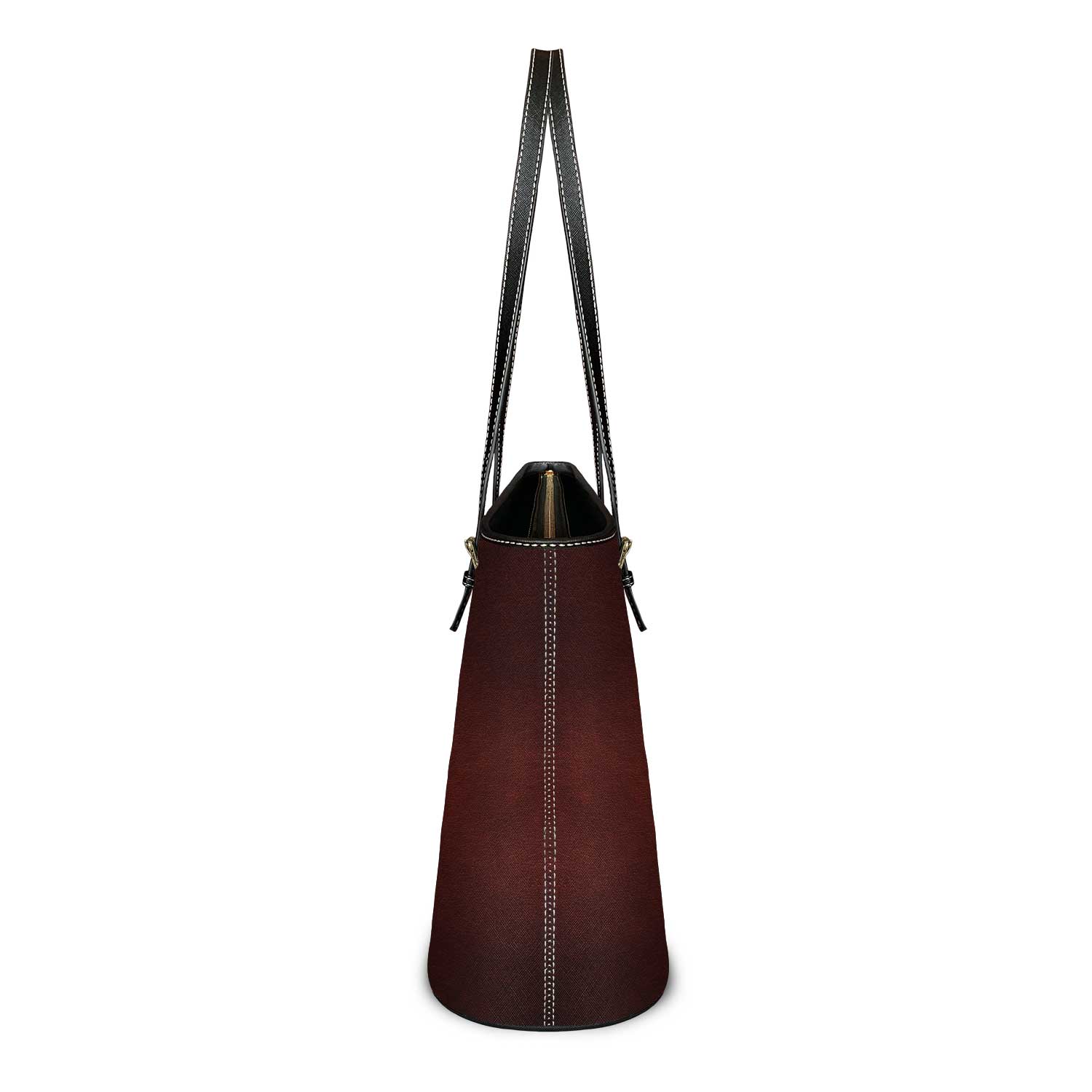





St. Teresa of Avila Tote Bag (Currant)
The St. Teresa of Avila Tote Bag features a beautiful double-sided custom print on a premium quality imitation leather tote bag. Comfortable and sturdy adjustable carrying straps with high-quality stitching for long-lasting durability. Soft, brushed polyester lining is finished with three interior side pockets to keep your items organized. A truly unique way to share your faith or a special holiday, birthday or confirmation gift.
■ Medium: 9.8"T x 15.7”W x 5"D
■ Large: 11"T x 17.3"W x 6"D
■ Adjustable 11" Straps
■ Zippered Top Closure

This is a couture item which is custom made-on-demand. Our couture collections feature exclusive, custom designs with our signature crown somewhere within the design. Not sold in stores and you won’t find this anywhere else. EXCLUSIVELY AT VENXARA.
Shipping + Delivery
These custom made-on-demand Tote Bags ship world-wide directly from our exceptional craftsmen in China. When placing your order, please use a physical street address for DHL Express delivery. DHL Express can not deliver to a PO Box. Destination tracking is available for most countries. A tracking number will be emailed to you once your order has shipped.
Production Time: 5-7 working days
DHL Express Ship Time: 3-6 days
Please Note: During peak shopping seasons, production and ship time may take a little longer than normal. If you are buying this item as a gift, please order as early as possible. We don't want to disappoint you or the gift recipient with a potentially delayed order.
For countries where tracking numbers are not available, this item should arrive by regular post within 2-4 weeks. Orders that have not arrived within 45 days of order processing are eligible for a free reshipment or a refund.
Materials + Care
MATERIALS
These Tote Bags are made with a high quality, textured imitation leather with a Safiano Finish created by the luxury designer brand Prada. This material is made with split leather (that’s the fibrous part of the hide left over from making genuine leather) which has been bonded with polyurethane. This material is extremely durable and the image will not fade, peel or flake. The interior lining is a soft, brushed polyester. These Tote Bags are vegan and eco friendly.
CARE
Your freshly made bag might arrive with a "new bag smell" (similar to a new car smell) that some people love and others do not. When you receive your bag, please unwrap it and allow the bag breathe for 24-48 hours to absorb the natural scents of its surroundings. To clean your tote bag, use a soft, damp towel to wipe away any dust or dirt. You can use a mild soap or gentle cleaning spray if needed. Please do not put this tote bag in the washing machine.
About St. Teresa

ST. TERESA OF AVILA
1515 — 1582
Feast Day October 15
Patron Saint of Spain, sick people, those who suffer from headaches and migraines, people in religious orders, people ridiculed for their piety and lacemakers.
Born in a small village in the province of Avila, Spain, Teresa lived in an age of exploration as well as political, social, and religious upheaval. It was the 16th century, a time of turmoil and reform. She was born before the Protestant Reformation and died almost 20 years after the closing of the Council of Trent.
The gift of God to Teresa in and through which she became holy and left her mark on the Church and the world is threefold: She was a woman; she was a contemplative; she was an active reformer.
As a woman, Teresa stood on her own two feet, even in the man’s world of her time. She was “her own woman” entering the Carmelites despite strong opposition from her father. She is a person wrapped not so much in silence as in mystery. Beautiful, talented, outgoing, adaptable, affectionate, courageous, enthusiastic, she was totally human. Like Jesus, she was a mystery of paradoxes: wise, yet practical; intelligent, yet much in tune with her experience; a mystic, yet an energetic reformer; a holy woman, a womanly woman.
Teresa was a woman “for God,” a woman of prayer, discipline, and compassion. Her heart belonged to God. Her ongoing conversion was an arduous lifelong struggle, involving ongoing purification and suffering. She was misunderstood, misjudged, and opposed in her efforts at reform. Yet she struggled on, courageous and faithful; she struggled with her own mediocrity, her illness, her opposition. And in the midst of all this she clung to God in life and in prayer. Her writings on prayer and contemplation are drawn from her experience: powerful, practical, and graceful. She was a woman of prayer; a woman for God.
Teresa was a woman “for others.” Though a contemplative, she spent much of her time and energy seeking to reform herself and the Carmelites, to lead them back to the full observance of the primitive Rule. She founded over a half-dozen new monasteries. She traveled, wrote, fought — always to renew, to reform. In her self, in her prayer, in her life, in her efforts to reform, in all the people she touched, she was a woman for others, a woman who inspired and gave life.
Teresa who became a celebrity in her town dispensing wisdom from behind the convent grille, was also known for her raptures which sometimes involved levitation. It was a source of embarrassment for her and she bade her sisters to hold her down when this occurred. The fact that she wrote down virtually everything that happened to her during her religious life, means that an invaluable and exceedingly rare record from the 16th-century has been preserved.
Her final illness overtook her on one of her journeys and she died in 1582 at the age of 67. Her last words were: "My Lord, it is time to move on. Well then, may your will be done. O my Lord and my Spouse, the hour that I have longed for has come. It is time to meet one another."
Teresa was buried at the Convento de la Anunciacion in Alba de Tormes. Nine months after her death, the coffin was opened and her body was found to be intact but her clothing had rotted. Before the body was re-interred one of her hands was cut off, wrapped in a scarf and sent to Avila. Father Gracian cut the little finger off the hand and - according to his own account - kept it with him until it was taken by the occupying Ottoman Turks from whom he had to buy it with a few rings and 20 reales. The body was exhumed again on November 25, 1585 to be moved to Avila and was found again, to be incorrupt. An arm was removed and left in Alba de Tormes at the nuns' request, to compensate for losing the main relic of Teresa, but the rest of the body was reburied in the Discalced Carmelite chapter house in Avila.
In 1970, the Church gave her the title she had long held in the popular mind: Doctor of the Church. She and Saint Catherine of Siena were the first women so honored.
Choose options






